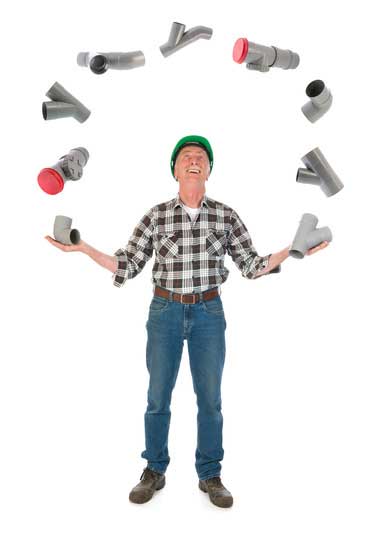In more modern residential and commercial properties, a drain waste vent, also referred to as a DWV, is a part of the system responsible for eliminating sewage and gray water from a building. In addition, this type of system helps regulate air pressure within pipes to facilitate flow.
Waste, which is produced at toilets, showers, and sinks, exits and then goes through a special trap. The trap is a portion of the pipe with a unique curve or bend to retain a small amount of water.
DWV Overview
The primary purpose of these systems is to ensure air pressure in drains remains neutral. With that, water flow and sewage have the ability to go down drains and, with the force of gravity, through waste pipes. For this reason, there has to be a very specific downward slope. Although rare, there are instances when a DWV system cannot slope, so a collection pit and grinding life sewage ejector pump are required.
To prevent dangerous sewer gases from filtering into the home, all fixtures must have a trap. All fixtures are connected through these traps that go to waste lines. These lines are designed to transport waste to a soil vent or soil stack pipe.
Attached at the lowest point of the drain system is the drain waste vent. Typically, this vent goes up through a wall and then out to the roof. Through a building drain, waste flows out of the building where it reaches a sewage line. This line then goes to a public sewer or septic tank.
As part of the venting system are pipes that go from waste pipes to the outside, usually through a portion of the roof. In addition to eliminating sewer gases, vents admit oxygen that promotes aerobic sewage digestion. Simply put, on both sides of the trap, vents offer a means of pressure equalizing while allowing the small amount of trapped water to maintain the effectiveness of the trap.
Regardless of the type of fixture, either an internal or external trap is required. While some people will add two traps, this is actually prohibited according to plumbing code, because there is too high a risk of clogs forming. In addition, fixtures are supposed to have an attached vent, although there are a few exceptions.
Purposes of DWV Systems
The way a sewer pipe works is by maintaining neutral air pressure compared to pressure within the surrounding area. That way, when wastewater goes through a pipe, the air is compressed to create a positive pressure needed to stop the stream of waste and water seals on downstream traps from pushing back.
To avoid negative pressure from building, air has to flow in behind the stream of waste as water passes through; the volume of water discharge is determined on fluctuations of these pressures. In the event that too much negative air pressure builds, it can cause water from traps and fixtures to be siphoned. Usually, the toilet is at greatest risk, since its trap seal is the shortest. If a trap empties, dangerous gases are emitted into the structure.
While negative pressure is typically the biggest concern, a unusually high level of positive pressure can also be a problem. When this happens, wastewater forces back into the fixture, which then causes the trap seal to break. This type of issue can occur within a home, but it is more often seen in buildings that are three or more stories tall.
Viable Solutions
To prevent high pressure in a drain system, usually sewer pipes vent through one of two ways.
- Atmosphere Venting – Drainage systems for homes in North America are usually vented through the roof with a DWV-rated plastic pipe fitted with a flashing. This keeps rainwater from getting inside. Under many building codes, a pipe that leads to the main roof vent, known as a vent stack, is required within five feet of a toilet, shower, or sink.
- Island Fixture Venting – For venting bathrooms and sinks where it would be impossible to install a vertical vent, an island vent is the alternative solution. With this, pipes that come from within the island are then turned downward prior to connecting to a horizontally installed vent stack.
A professional plumber can assist with any problems associated with a DWV. While these can be big jobs that require time, a licensed plumber will know exactly what to do and the codes to follow. Dealing with the drain waste vent system is not a do-it-yourself type project.
